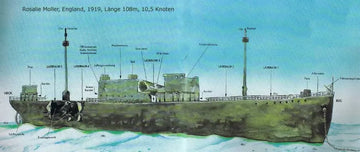The Rosalie Moller is one of those remnants left at the bottom of the Red Sea during the World War II that has become a delight for the more experienced divers. This 108 meter long cargo was carrying coal in 1940 when, close to Gubal Island (to the north of Hughada) was bombed by two German planes.
By the way, in case you're not familiar with us, before proceeding with the article, know that we have a uniquely original collection of T-shirts inspired by the Red Sea, as well as another designed specifically for divers :-)
 Rosalie Moller, one of the best deep diving destinations in the Red Sea. Pic by Hartlepool
Rosalie Moller, one of the best deep diving destinations in the Red Sea. Pic by HartlepoolThe wreck lies today at 50 meters depth, hence it is not suitable for novice divers and requires experience to dive on it. It is considered an excellent destination for deep diving in the Red Sea.
Beginnings
Built in Glasgow by Barclay Curle & Co, the Rosalie Moller was launched as the "Francis" in January 1910 and started operating with the Booth shipping company. It was a cargo of 108.2 meters in length with engines that gave it an incredible speed of 10 knots, something extraordinary to early last century.
______________________
The best liveaboard offers in the Red Sea
______________________
In March 1931 the ship was sold to the Lancashire Moller company and renamed "Rosalie Moller". Until then the ship worked around the British and European coastlines, but was soon commissioned to load operations in China, Shanghai and Tsingtao (now Qingdao). During World War II (1939-1945), the Ministry of Transportation called on all British ships to serve as war machines or support vessels. The Rosalie Moller was one of those ships.
 Freighter Francis in 1910, before being renamed Rosalie Moller
Freighter Francis in 1910, before being renamed Rosalie Moller
In 1940, the Rosalie Moller was sent back to Liverpool and became part of the Royal Navy to transport Welsh coal to wherever it was required. During the early months of being part of the Royal Navy, the Rosalie Moller, which had a capacity of up to 4,500 tons, was stuck to Gibraltar and the British Isles but gradually went deeper into the Mediterranean sea towards Malta, where heavy battles were taking place with German submarines.
In July 1941, the Rosalie Moller engines received a thorough review before the task that would be its last. Loaded with 4,680 tons of coal, it was sent to Alexandria. The only way to get there, with the Mediterranean route being controlled by the Third Reich, was through South Africa and then up the Red Sea. Three months after starting the journey the Rosalie Moller was in the Red Sea waiting for permission to enter the port when two Heinkel He 111 based in Crete were looking for a large vessel that carried troops to northern Africa. These aircraft casually found two transport ships, the legendary Thistlegorm and the Rosalie Moller.

Two Henkel He 111 bombers sunk to the bottom of the Red Sea the Rosalie Moller and the Thistlegorm
The Rosalie Moller was sunk into the sea 48 hours after the Thistlegorm. Both wrecks took the lives of 11 people with them.
50 years disappeared
After the World War II the lack of raw materials led to the search for the sunken ships in the Red Sea to recover their cargo. The Rosalie Moller appeared as recovered in the files, but actually no one had found it, ... until 1998.
In December 1998 an optimistic expedition that after careful study doubted that the boat had been recovered after the war, found it almost 50 years after its sinking.
Diving the Rosalie Moller
The Rosalie Moller is in good condition because it is one the less dived wrecks in the Red Sea and it was discovered quite late. The cargo hatches have disappeared revealing the full load of coal in the hold. You can also still find hanging pots and pans in the kitchen and, although the wood decks have rotted, all portholes are in place, even with the glass.
Diving in the Rosalie Moller wreck
At the leading edge there is a small staircase leading up to a beautiful copper whistle in very good condition. The rear mast is intact and also the rudder, about 45 meters deep, and one of the four propeller blades.
The aft area can be accessed through the collapsed chimney where you can see the hole left by the bomb on the port side and where there still are the kitchen and lifeboats. This is the deepest part of the wreck.
It is possible to penetrate the wreck through the cargo holds on the main deck. These holds have 2 levels and keep some bags with coal. Be careful on the second level as it is more than 40 meters deep and the visibility is quite poor, complicating the dive.
If you explore the bow of the boat you can reach the passenger lounge and look inside the rooms, which today have become home to many breams, fusiliers, jacks, barracudas and glass fish. On the cover, you have several outcrops of coral and anemones, clownfish and lionfish that arrive in the early morning to feed on tuna juvenile schools.
The ship is not in regular diving routes and, unfortunately, does not enjoy the high levels of visibility offered by other wrecks like the Salem Express.





















